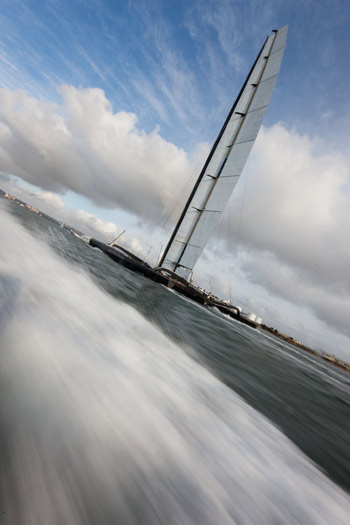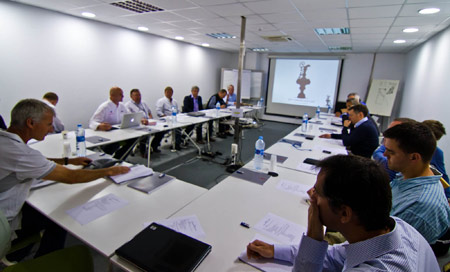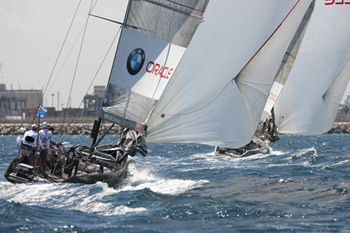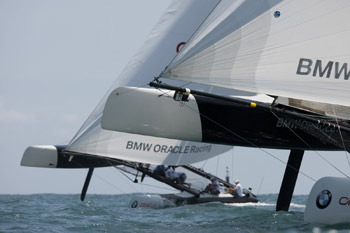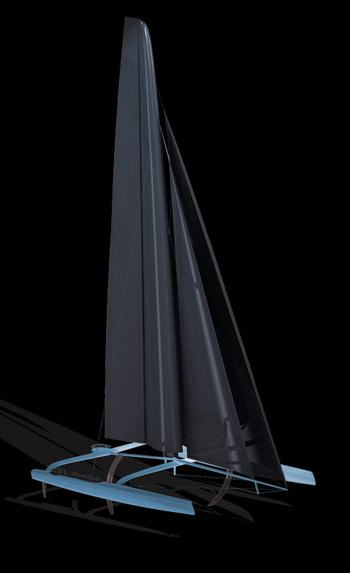|
|
||||||||||||||||||||||
|
How Did the 2013 America's Cup End Up in
Multihulls? January 17, 2011
|
||||||||||||||||||||||
|
Pete Melvin is a diehard multihull guy. For that reason, he pretty much figured the pinnacle of sailing, the America’s Cup, was out of his reach. But an improbable Deed of Gift match led to the chance of a lifetime -- bringing Melvin and his team to the forefront of plans to bring multihulls to the venerable Cup. The team at Morelli & Melvin, the Huntington Beach, California, yacht design firm who helped design the wing and other features of BMW Oracle Racing's USA-17 trimaran. But when America’s Cup 33 ended last February, Melvin celebrated the victory and thought his time with the Cup had come to an end. However, a seed had been planted. “During the Cup, I honestly don’t think anyone was thinking that far ahead,” Melvin says. “It was all new to most of the Oracle guys. I mean, you can count the number of guys who had been involved with multihulls -- especially multihulls with wings -- on two hands. It’s a very small community. They weren’t sure how that was going to turn out, so no one was thinking about how the next Cup was going to look.
“Around a month after the America’s Cup ended, everyone realized it was time to get serious about the next one. A lot of opinions were being formed over the course of the match and even within Oracle a lot of people thought it would go back to monohulls the next time, that this was just an aberration, that they’d built the fastest boat within the Deed and that was it. That was the general feeling -- and Larry Ellison had even stated that several times - that if they won, they’d go back to monohulls. “But you could see, working with the design and sailing team, most of them said, ‘Gosh, this is so exciting and so much fun, we really hope it stays in multihulls!’ And among the sailors, they were used to two-boat testing where they’d be out there grinding away for hours on end, just changing one little inch on some rope, and it was really tedious, but this was all just wild open development. We’re not just dialing the knobs in, this was all totally new thinking, clean sheet of paper and a lot more exciting intellectually. That had been percolating for a while, so after Larry sailed on the boat in the last race, he really started getting a buzz for the whole multihull thing, as did Russell.” So much so that when it became time to start thinking about the next Defense, BMW Oracle leaders took a serious look at the possibility that the future of the America's Cup could lay in multihulls. And if you’re thinking multihulls, there’s only one place you call; they dialed-up Melvin & Morelli. “We were elated to get that call in March, to ask if we could help develop a concept for a multihull for the America’s Cup,” said Melvin, with a smile. “We worked with the Oracle guys on the concept for a couple of months, culminating at a designers’ meeting in Valencia with everyone in attendance. We went in with no pre-conceived ideas of what it should be, our thought was just ‘Let’s open up the envelope of multihulls.’ We looked at the matrix of boats from 60 to 80 feet long, catamarans and trimarans, and looked at all the options -- what each of those options might cost, how difficult the boat would be to handle, what kind of loads, logistics, all of that. So we narrowed our ideas down to a 70-foot trimaran with standard sails. “We’d looked at an 80-foot trimaran, which is a much bigger and more powerful boat, but it had an engine and I don’t think anyone wanted to see that move forward. But we wanted to show a couple of options and see what kind of comments we got back. And it was fairly unanimous between the designers that they didn’t want an engine. So we knew the 72 footer -- similar in power to, say, an ORMA 60’ trimaran, where you could sheet loads and power the thing with humans pretty aggressively and sail around a course -- was a pretty good size.” Melvin believes that, in the end, the rampant sentiment against using onboard power on America's Cup yachts was the downfall of the monohull.
“I think in the end a big driver against the monohull was the engine. In the meeting, Bruce Nelson did a really good job of laying out different monohulls in that size range with deep-draft fixed keels, retracting keels, canting keels -- it was clear that you either had to have a retracting keel or a canting keel. The canting keel was the preferred choice, because the performance was better. But the downside was that you’d really need an engine to match race the thing.” Melvin realized the potential was there for fallout from traditionalists worried that multihulls are not the America’s Cup, but the chance to be involved in the most high-profile event in sailing overrode any fear of backlash. Especially since Melvin was only proposing the idea, not making the decision. “We’re not really the front line on receiving criticism for the choice of vessel,” said Melvin, “so we’re a little bit insulated from that. It wasn’t our choice, it was Larry Ellison’s and Russell Coutts’ choice.” Following the proposals in May, Melvin and the multihull contingent had to wait through an extensive series of on-the-water studies off Valencia in the summer that took hard looks at both the multihull and monohull options in practical situations. Despite the fact that the best choice of yachts was being debated, deadlines for a public fall announcement required moving forward on design development and class rules, even though that meant advancing both classes on parallel tracks. For Melvin, he had to have believed that even with the engine proposition sandbagging the monohulls, the deck was stacked against him.
“After the May meeting, the idea was that they would make a decision about the type of boat based on the information presented at the meeting, so we were all waiting to hear. They contacted us a few weeks later, saying they still hadn’t made up their minds, that they wanted to do more research, but they realized that time was getting short, that they needed to start working on a rule. A rule takes time. So they had us continue forward creating a rule, but they also had a team in the UK overseeing writing a monohull rule. In the meantime, they were doing trials in Valencia, with the Extreme 40 and the RC44, getting input from different areas to figure out the big puzzle of what they thought would be better for the America’s Cup as a whole. I thought that was a great way to go about it, getting opinions from all these different experts, like engineers, designers, media people, event organizers, teams. “When they first asked us to start working on a concept ... even at that designers meeting it was extremely one-sided. Most of the people in the room were monohull people -- most of the community is. There were only two or three of us who were dyed-in-the-wool multihull designers. It was extremely clear along party lines with most everyone wanting monohulls and us multihull guys saying ‘We’re open minded, but we see more benefits in the multihull than you guys are seeing.’ But it comes down to match racing. The biggest criticism from the monohull guys was ‘You can’t match race these boats.’ There are very few people who have really match raced a multihull. I was fortunate enough to have been involved with the Oracle guys in their match racing development and knew how exciting it could be, but it’s hard to tell the monohull people ‘Wait and see, it really will be great!’” By the time September came, and with it official word that the new boat would be the 72’ catamaran, Melvin and his crew were knee-deep in what would become the AC72 rule for the 34th America’s Cup.
“We embarked on writing a rule and had four months to do it, so it was a fairly fast time pace. I think last time, they took a year to write the rule -- but we didn’t know that! We put a lot of resources into it, with four or five people from our office working on it plus a bunch of outside consultants. That was another good thing the Oracle guys did; they wanted to be removed from the rule writing part of it completely. They wanted to make sure we got a balanced, even approach and that we had checks and balances to ensure that everyone agreed with it, that this was the right way to go. Teams are going to be spending millions on these boats and hopefully for a period of years, so it was super important to get the rule right. So there was definitely some pressure on us. “At first, we worked mostly on the technical aspect of it, what the boat should look like, catamaran versus trimaran, wings or sails. At the end of the day, it came down to someone saying ‘Let’s move forward’ and it was Russell in the end who decided to go with a catamaran with a wing sail. The biggest reason for a catamaran was transportation. When we first started working on this, there was very little reason to have to transport these boats via aircraft, but it became more desirable as the studies went on and they started thinking about the events and how they might be run. So that was one of the main reasons for a catamaran.” Speaking of transportation: 5.12 of the AC72 Class Rule stipulates that each yacht, hull, and cross structure shall be capable of being disassembled and packed in shipping boxes within 24 hours and capable of being reassembled within 48 hours. That’s a bloody tight schedule. But that’s the deal, says Melvin. “You have to be able to put them on a ship. Most of the
time, the boat will stay together. The idea is that there’s a schedule and
the next event, you have to be able to pack the boats up and send them off to
the next port. I can’t tell you if the schedule will be that tight, but
you’d better be prepared to do that, or you might miss the boat! (laughs).” -- Diane Swintal for CupInfo/©2011 CupInfo Also see Part 2 with Pete Melvin: The Wingsail and the AC72 Rule Links of Interest: Read more about the AC72 Class Rule Firm Website: |


